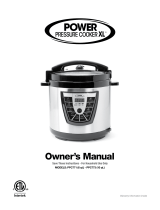
9
4. Cooker will start cooking within 3
seconds. Display will show “ON” until
pressure is reached, then cooking time
will begin to count down. When cooking
cycle is complete, Cooker automatically
switches to WARM mode.
5. Release steam by natural or quick
release method. See “Releasing Steam”
instructions in “Meet Your Pressure
Cooker.”
6. Press CANCEL at any time to stop
cooking. Display shows “OFF.” Always
release steam before opening Lid.
7. Unplug.
NOTES:
• When all pressure is released, Lid
will automatically unlock. Rotate Lid
counterclockwise to unlock. Remove Lid
carefully, allowing excess moisture on Lid
to drain back into Cooking Pot.
• Be aware that certain foods, such as
applesauce, cranberries, pearl barley,
oatmeal or other cereals, split peas,
noodles, macaroni, rhubarb, or spaghetti
can foam, froth, and sputter, and clog the
pressure release device (Steam Release
Valve). These foods should not be cooked
in pressure cook mode.
Pressure Cooking Tips
• Cooking times for pressure cooker
recipes can be up to 70% faster than
traditional methods. To adapt recipes,
start by reducing time by half.
• The amount of liquid needed is much
less than traditional cooking methods.
To adapt favorite recipes to a pressure
cooker, reduce liquid by about half.
• Liquid is required to create steam and
build pressure in the Cooker. Always add
a minimum of 1 cup (237 mL) water or
other liquid.
• Fill Cooking Pot no more than 2/3 full. For
foods that expand such as rice or beans,
fill 1/2 full.
• Remember that the countdown for
cooking time will not start until pressure
has built in the Cooker and Lid is locked.
Average time is 10 to 15 minutes but can
be much longer.
• When cooking rice, use a 1:1 ratio for
rice to water. Rinse rice before cooking.
• Add 1 tablespoon (15 mL) oil to rice or
beans to reduce foaming and splattering.
• Beans do not require soaking, but
soaking beans for at least 3 hours will
yield softer, more consistent results.
• Steam foods by adding at least 1 cup
(237 mL) water to bottom of Cooking Pot.
Place food on Roasting Rack in Cooking
Pot. Press STEAM mode button and
follow desired recipe. Frozen vegetables
can be steamed from frozen state: add
1 to 2 minutes to the time indicated on
package directions.























